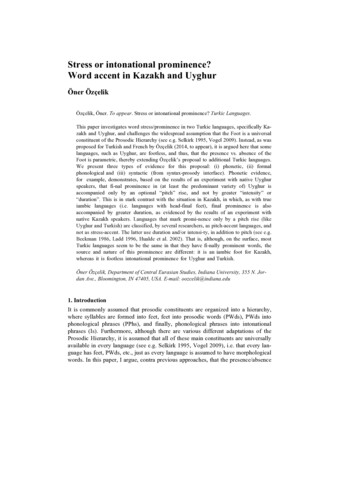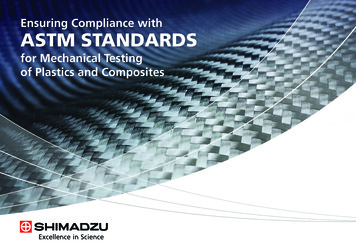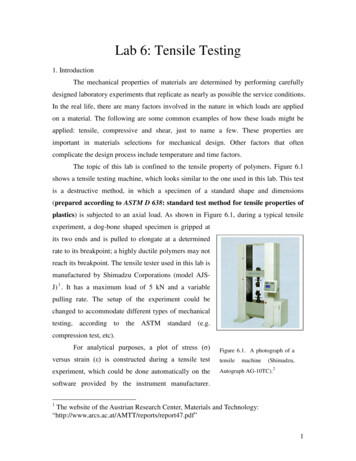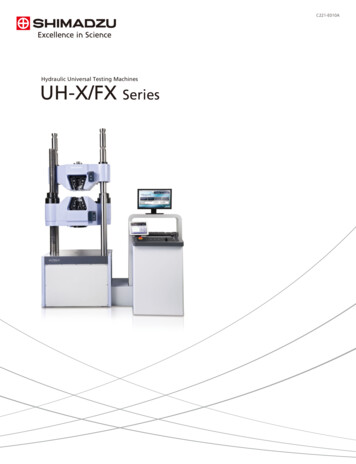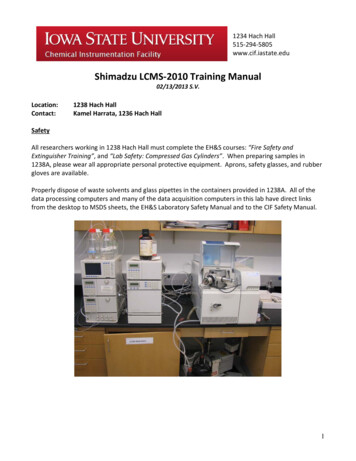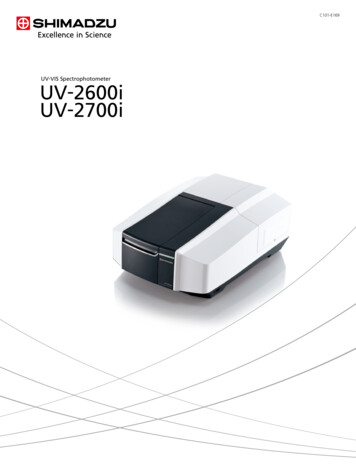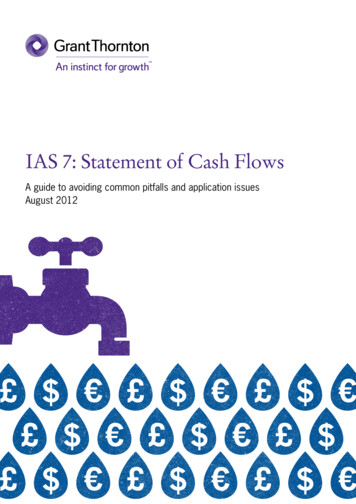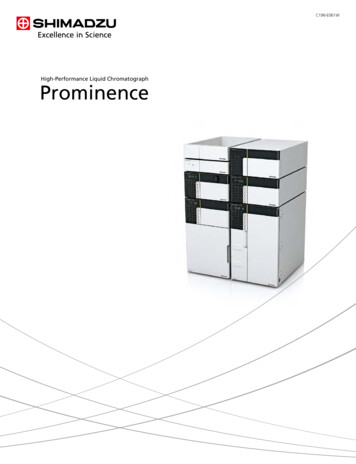
Transcription
C196-E061WHigh-Performance Liquid ChromatographProminence
High Performance Liquid ChromatographH ow HPL C Should BeHigh-performance liquid chromatography (HPLC) is widely usedin diverse fields such as pharmaceuticals, and biochemistry tochemistry, the environment, and food products.The Shimadzu Prominence high-performance liquidchromatograph achieves an exceptional level of performance ineach of these fields.Prominence HPLC offers exceptional reliability and greatexpandability to support diverse applications from ultra-fastliquid chromatography to preparative LC, gel permeationchromatography (GPC), ion chromatography, and LC/MS.
ProminenceSuperb Performance and ExpandabilityProminence keeps becoming more advanced.By incorporating state-of-the-art improvements developed based on feedback, Prominence systems offer customers an analytical systemwith high reliability, in addition to exceptional performance and expandability.System controllerKey Improvements・Remotely monitor instrument status usinga portable terminal, such as an iPad・Overlapping injection function results inshorter analysis timesPump・Check valve improvements provide morestable solvent deliveryPhotodiode array detector・More sensitive variable optical pathlength preparative cell and improvedbaseline stability・Enables complete separation ofunseparated peaks or visualization oftiny peaks hidden behind primarycomponents ( i -PDeA/ i -DReC functions)Quaternary gradient unit・Stronger support for buffer solutionswith high salt concentrationsFluorescence detectorAutosampler・Data acquisition using multi-wavelengthmode・Multi-rinse function (max. two solutions)achieves even lower carryoverColumn oven・Improved leakage detection (leak sensor)・Improved separation in simultaneousanalysis of multiple components bysimultaneous control of up to four unitsWide Variety of Application Systems AvailableSeveral application-specific systems are available that take advantage of the remarkable expandability of Prominence systems. Thesesystems represent a consolidation of our extensive instrument and analytical experience cultivated together with customers thus far.Examples of analysis using these application systems are available in our application database and featured in Application News bulletinsand the member website Solutions Navigator.FoodsChemical IndustryFood componentsResidual pesticidesAdditivesFragrancesPlastics SolventsFiber and inking waterSoilBiofuelsDrug ingredients Antibiotics and antimicrobialsHerbal medicines, natural productsVeterinary pharmaceuticals Amino Acid Analysis System Synthetic Antimicrobial Analysis System GPC System Organic Acid Analysis System Bromate Analysis System GPC Cleanup System Reducing Sugar Analysis System Cyanide Analysis System Preparative System Carbamate Analysis System Anionic Surfactant Analysis System Co-Sense Series Iminoctadine Analysis System Aldehyde Analysis System
Strong Support for Ensuring the Reliability of Analysis Data and Enhancing ProductivityIn analytical laboratories, it is necessary to ensure that there havebeen no errors or irregularities in the procedures used to obtainresults from the acquired data. Confirming test results andmaintaining accurate analysis operational logs are also required.This is in order to ensure both the accuracy of the acquired dataand the reliability of analysis data.LabSolutions Report Set visualizes software operations to ensure thereliability of analysis data. At the same time, the amount of timeneeded to confirm analysis results can be reduced to 1/2 or 1/3.1. Visualization of the Sequence of Analysis Operations Ensures Reliability and Reduces the Burden of Confirmation ProceduresInformation from a sequence of analyses (batch analysis), analysis results and conditions, and even the entire operational log from the startto the end of analysis procedures are summarized in a single PDF file (Report Set). This simplifies confirmation of analysis results andoperations, thereby ensuring reliability and reducing the burden of confirmation procedures.2. The Sequence of Analysis Results Is Automatically Protected Against TamperingEditing of the sequence of analysis results subject to visualization is automatically disabled, preventing the revision, substitution, ortampering of results.As a result, revision, substitution and other forms of tampering with the analysis results is prevented. In addition, the visualized Report Setand the sequence of analysis results are linked, allowing individual analysis results data sets to be searched and checked easily.3. Digitization of the Confirmation Process for the Analysis Results Report Enhances ProductivityA report confirmation record can be left at any point in the analysis results report output as a PDF file. If any items have not been checked,an error is issued, preventing omissions in the report confirmation process. In addition, electronic signatures can be used for theconfirmation of the Report Set. These functions simplify on-screen confirmation, enabling paperless operations and heighteningproductivity.Inside the LabSolutions DatabaseImplementation of analysisPreparation ofsamplesGeneration and storageof analytical dataLogoutLoginLink(Between data to the Report Set)Analysis conditionssettingsPeak integrationparametersBatchsettingsPDFReport SetBreakdown of the Report SetCheckerBatch reportsOperational log reportsCheckInstrumentparametersElectronic signatureLoginLogoutApproverBreakdown of Other Reports Instrument parameter reports Data processing parameter reports Calibration curve reportsChromatographyreportsApprovalOther reportsElectronic signatureLoginLogout Report Set is a PDF file that gathers operational information (human-mediated operations and settings) scattered within the software, as well as batch(sequential analysis) reports and chromatography reports, and summarizes them in a single report. This Report Set can be created with a single operation. As with analytical data and method files, the PDF Report Set is produced and stored in a security-controlled database. Also, the software that createsthe PDF Report Set is incorporated in LabSolutions, so there is no need to apply separate validation for PDF creation software.Note: The LabSolutions Report Set function is intended for LabSolutions CS and LabSolutions DB.High Performance Liquid Chromatograph5
Solvent Delivery UnitsLC-20ADSuperior Solvent Delivery PerformanceThe LC-20AD offers the fastest solvent delivery performance in the world. With an automaticpulsation-correction mechanism and high-speed micro plunger driving, it achieves pulse-free solventdelivery. Thanks to improvements in solvent-delivery control firmware, solvent-delivery performancein the micro-flow-rate range below 50 µL/min has been significantly improved.LC-20ABBinary Solvent Delivery UnitThe LC-20AB is a binary, high-pressure gradient solvent delivery unit that incorporates two sets ofLC-20AD systems. Its space-saving design can be used to create a two-solvent high-pressure gradient.LC-20ATSuperior MaintainabilityThe LC-20AT possesses a high level of maintainability while delivering high performance. The abilityto remove bubbles has been improved by modifying the pump-head structure and the flow line.LC-20AiSolvent Delivery Unit for Inert LC UnitWetted parts are made from plastic, such as PEEK, without metal. Therefore it is corrosion-resistantto halogen ion, such as sodium chloride often used for biological polymer analysis. This unit is usefulfor analyze chemical compounds with metal materials that change in activity by contact with metal.Low-Pressure Gradient UnitThe optional low-pressure gradient unit can be incorporated in theLC-20AD/20AT, enabling gradient elution in a compact space witha small void volume. Automatic matching adjustment of thesolenoid valve and pump gives concentration accuracies of 1.0%.Accurate Gradient Solvent DeliveryBy harmonizing two solvent delivery systems, the LC-20AB deliverssolvent with an accurate concentration across a wide range fromthe micro flow rate region to the conventional flow rate region.mAU500Set value(%)1020304050607080904003002001000A new type of plunger made with a technique that reflectsconsideration of the material structure and a preciseplunger-holding mechanism help to increase the service life ofplunger seals and enable stable solvent delivery over long periods.Plunger supported by floating mechanismContinued Improvements toSolvent Delivery SpecificationsThe flow rate accuracy and precision in the micro flow rate regionhave been improved thanks to the adoption of a new type of checkvalve and modifications to the solvent-delivery control method.Nonpolar organic solvents, such as hexane, can be delivered stably.Flow-Rate AccuracyPlunger seal and center in alignment6Measuredvalue w-Rate PrecisionSet value(mL/min)Measured value,n 6 (mL/min)Set 0000.0100.0500.2001.000Flow-ratereproducibility,n 6 (RSD%)0.490.080.080.01
LC-20AR / 20APSupporting from Analytical to Preparative ScalesThe preparative LC system supports both analysis and fractionation (including gradient analysis andfractionation), which permits efficient scaling up with a single instrument and single operating environment.The solvent delivery unit LC-20AR can handle flow rates ranging from those used in accurate analytical scaleto those used in semi-preparative. It enables semi-preparative recycling by using a recycle kit.The high solvent delivery performance of the LC-20AP permits an accurate and efficient environment forscaling up, in both the preparative and analytical flow rate ranges.The LC-20AP Quaternary which is combined the LC-20AP with a dedicated FCV-200AL low-pressure gradientunit, allows gradient fractionation to be performed in a single unit, thereby saving equipment costs.High-Precision Delivery PerformanceSupports from ParameterInvestigation to Scaling UpTypical values of the total component weight for a single injectionperformed by a 250 mm column, where the target component is(1) highly soluble in the mobile phase, (2) separated fromcontaminating components, and (3) subjected to ion suppression,are indicated on the right. With isocratic elution, these values arebasically proportional to the volume of the column.20 mg300 mgSemi-micro AnalyticalAnalysis Semi-preparative2 mmI.D.5 mmI.D.20 mmI.D.0.010.1123Samples(retention timeat %RSD n 6)41: Methylparaben(0.015%RSD)600Preparative40050 mmI.D.2002: Ethylparaben(0.011%RSD)3: Propylparaben(0.008%RSD)010LC-20AT18002gFlow Rate (mL/min)0.001mV12001000Typical Maximum Load (Single Injection, Column Length of 25 cm)3 mgA redesigned plunger actuation mechanism and improved pulsecorrection and check valves offers significantly improved flow rateaccuracy and flow rate precision. High retention timereproducibility for analytical flow rates improves reliability whenscaling up and verifying purity.100110 mL/minLC-20AR4: Butylparaben(0.010%RSD)2345678910 minFlow rate: 1.0 mL/minRetention Time Reproducibility for Analytical Flow Rates20 mL/minLC-20AP150 mL/minLC-20AP Quaternary Enables Fractionation as a Low-Pressure Gradient SystemThe LC-20AP Quaternary flow rate range is 1 to 50 mL/min and the instrument can handle up to four mobile phases simultaneously.It considerably reduces the effort required to investigate mobile phases during method development.ColumnCarnosic acid1000CarnosolRosmarinic acidmAU1500A: Water B: Methanol C: 2 % aqueous formic acid solutionGradient programB. Conc. 30 % (0 min) to 95 % (15 to 30 min) C. Conc. 5 %Column temperatureInjection volume50005.010.015.020.025.0Room temperature200 µLFlow rate20.0 mL/minDetectionUV 230 nmSample0.0Shim-pack PREP-ODS 250 mmL. 20 mmI.D., 15 µmMobile phasesRosemary extractminDegassing Units DGU-20A3R / 20A5RThe DGU-20A3R/20A5R is an on-line degassing unit that uses fluoroethylene membrane. The internalcapacity is small at 0.4 mL, only 1/25th of that for existing Shimadzu models, and the waiting time atmobile-phase replacement or stabilization can be significantly reduced. The degassing efficiency hasalso been improved, ensuring thorough degassing even at high flow rates.Number of degassed solvents for DGU-20A3R : 3Number of degassed solvents for DGU-20A5R : 5High Performance Liquid Chromatograph7
AutosamplersSIL-20A / 20AHTSupporting High-Throughput AnalysisThe SIL-20A is a total-volume injection-type Autosampler that enables high-speed injectionand multi-sample processing. It was designed to ensure greater stability, with improveddurability attained through modifications in valves and sample loops.SIL-20AC / 20ACHTEquipped with Cooling FunctionThe SIL-20AC is equipped with a sample cooler that incorporates a dehumidifying function.Samples can be maintained at a fixed temperature in the range of 4 to 40 C. The highcooling speed makes it possible to keep easily decomposed sample constituents in a stablecondition.Rack Changer IISupporting Multi-sample ProcessingMaximum 12 microplates can be set. The robot arm in the rack changer automaticallyloads both micro-plates and racks for standard 1.5 mL vials into the autosamplers. It is apowerful tool for the analysis of a large number of samples.Sample Carryover Reduced to an Absolute MinimumAdsorption of sample constituents has been reduced to an absoluteminimum by using a special processing technology for the samplingneedle (patent pending) and rethinking the structure of the needleseal and the materials used in flow-line parts. As a result, there ishardly any sample carryover. Also, the adoption of a PEEK rotorseal allows use over a wide pH range, from strongly acidicconditions to strongly basic conditions. Using the optional rinse kit(228-43042-91)makes it possible to rinse the sampling needle with two differentsolvents, selected in accordance with the purpose.Easily adsorbed compoundscan be handled with the SIL-20A.They are hardly detected atall with a rinsing pump.Not detectedCross-contamination Test for ChlorhexidinePrecise Sample InjectionGreater accuracy has been attained by incorporating ahigh-performance sampling device that can measure out thesamples with high precision. The design reflects an emphasison basic performance as well as functionality. Also, usingdirect injection means valuable samples are not wasted.8Injection-Volume AccuracySet value (µL)Measured value (µL)Injection-Volume PrecisionInjection volume (µL)Area reproducibility 019.92200.035049.90500.1010099.701000.11
Rack Changer II: Increasing the Number of Processed SamplesA rack changer is an optional product that can be used to change the microplates in theautosampler’s racks and thereby facilitate serial analysis. Up to 12 plates can be mountedin the rack changer.This model incorporates a cooling function. When the samples have been prepared, simplyset them in the rack changer to perform continuous sample processing.Rack changer II (228-45164-XX)Compatible plates: 96-well MTPs, 96-well DWPs384-well MTPs, 384-well DWPs1.5 mL vial plate (54 vials)Number of processed plates: 12Sample cooler: Block cooling/heating, used together withdehumidifying function, 4 to 40 CProminence UFLC Offers Ultra Fast HPLC AnalysisThe SIL-20AHT / 20ACHT autosamplers usedwith the Prominence UFLC system permitultra-fast analysis while maintaining theinjection accuracy and durabilityrequirements demanded of an HPLC system.As shown in the right, the retention timereproducibility and injection volumereproducibility are within 0.3 % afterendurance testing over 100,000 cycles,results similar to those achieved withstandard HPLC.mAU240Retention rophenone3.3410.031296,6090.040200%RSD(5 µL injection, n 6)500 100.00.51.01.52.02.53.03.5 minRepeatability for 4 Alkyl Phenones After Finishing 100,000 Cycle Endurance TestCombination with LCMS for Ultra Fast AnalysisCombining Prominence UFLC with aShimadzu mass spectrometer, whichfeatures ultra-fast polarity switchingbetween positive/negative ion modes(UFswitching), superb sensitivity due to thenewly-developed Qarray ion optical system(UFsensitivity), and an ultra-fast scanningspeed (UFscanning), enables ultra-fastanalyses that produce peak widths in just afew seconds and highly reliable data.DetectionColumnMobile phase621Flow rateTemperatureInjection volumeObserved analysiscolumn pressure : 14 MPa34: ESI-Positive mode; LCMS-2020: Shim-pack XR-ODS (30 mmL. 3.0 mmI.D.): A) 0.1% aqueous solution of formic acidB) AcetonitrileB.Conc.: 20% (0 min.) 35% (2.0 min.): 0.5 mL/min.: 50 C: 1 µL5TIC (Positive)TIC (Negative) 5m/z 355 (Positive)m/z 250 (Positive)m/z 265 (Positive)m/z 321 (Negative) 50m/z 329 (Negative) 50m/z 231 (Positive)0.00.51.01.5Peaks1: Yohimbine, [M H] m/z 3552: Alprenolol, [M H] m/z 2503: Tetracaine, [M H] m/z 2654: Chloramphenicol, [M H] m/z 3215: Furosemide, [M H] m/z 3296: Isopropylantipyrine, [M H] m/z 231minUltra-High-Speed Analysis of 6 Pharmaceutical IngredientsHigh Performance Liquid Chromatograph9
Extension拡張ModulesモジュールSystem ControllersWeb Server Functionality Allows the HPLC System to Directly Create a Network.CBM-20A/20Alite is connected to a computer by Ethernet. The LAN cable connections allow the instrument and computer to be located inseparated positions. Monitoring, simple operation control, and confirmation of the operation status can be performed on a mobile device.EthernetWirelessiPadEthernet Simultaneously monitor multiple systems on the same network Maintenance data on consumables can be acquired without impeding analysis Using an Apple iPad, monitor and use simple HPLC controls from anywhereAssess the Status of Lab Instruments in Real TimeInstrument maintenance data can be assessed at a glance. If parts in use exceed their control lifetimes, they are flagged with a “!” mark.Even more detailed information can be confirmed by logging in to the corresponding instrument.Operational Status for Multiple HPLCs at a GlanceUsing an iPad, operational status can be easily assessed, even from a separateroom. Having an iPad at your desk allows you to devote yourself to other projectswith peace of mind, knowing that you can quickly retrieve information aboutcompleted analyses or errors that have occurred, all without visiting the lab.Control over a NetworkMaintaining a clean LC system and analysis column is important in order to obtain highlyreliable data. The Shimadzu LC system Web server functionality provides a controlenvironment in addition to system monitoring. Remotely control column cleaning andconditioning from your iPad or desktop PC.Note: iPad is a registered trademark of Apple Inc.10
Column OvensExtension拡張ModulesモジュールThe column oven precisely controls the temperature around the column to support stableanalysis that is unaffected by changes in ambient temperature.It can contain various units and parts in addition to the column, including a manual injector(CTO-20A/20AC), gradient mixer, and high-pressure flow-line selection valves.CTO-30ASupports high-temperature analysis up to 150 CThe CTO-30A is a block-heating type column oven. It offers temperature control up to150 C and the intelligent heat balance mechanism extracts maximum performance from ahigh-efficiency column.CTO-20A / 20ACAccommodates multiple columnsThe CTO-20A is a forced-air circulation-type column oven. It offers temperature controlfrom 10 C below room temperature to 85 C.It allows setting of complex temperature programs, such as linear-wise or step-wiseheating and cooling. The CTO-20AC incorporates a cooling function. This electronic cooleroffers temperature control from 10 C below room temperature to 85 C.Precise Temperature RegulationTemperature ( C)CTO-20ACRoom temperatureInternal oventemperatureAnalysis time (hours, minutes)Changes in Room Temperature andInternal Oven Temperature in One DayRetention time (min)The interior of the oven is precisely regulated with a high-performance thermistor. Also, the temperature is calibrated at two differenttemperatures to ensure a high level of accuracy.Retention timeAnalysis time (hours, minutes)Changes in Room Temperature andStability of Retention Time for Vitamin A Acetate in One DayBuilt-In Flow-Line Selection ValvesThe CTO-20A/20AC can incorporate up to two flow-line selection valves, a manual injector, and a gradient mixer.The CTO-30A can also incorporate a flow-line selection valve and gradient mixer.Incorporation of Flow-Line Selection ValveMixerFlow-line selection valveManual injectorThe FCV-12AH/14AH/32AH/34AHHigh-pressure flow-line selection valve can be incorporatedand controlled. Position display is also possible.High Performance Liquid Chromatograph11
UV-VIS Detectors / Photodiode Array DetectorsExtension拡張ModulesモジュールThe lineup includes SPD-20A/20AV dual-wavelength absorbance detectors and SPD-M20A/M30Aphotodiode array detectors. The SPD-M30A incorporates a new type of capillary cell to offerhigher sensitivity and lower dispersion. All models offer temperature control for increasedbaseline stability with respect to temperature fluctuations and improved data reliability.SPD-M30APhotodiode Array DetectorSupports diverse applications from HPLC to UHPLCThis detector achieves a 0.4 10 5 AU noise level. The SR-Cell (Sensitivity and ResolutionCell) significantly cuts peak dispersion. This model supports analysis from conventional LCto ultra-fast and UHPLC analysis. The optional high-sensitivity cell has an 85 mm opticalpath length and is able to detect trace components that were conventionally difficult todetect. The TC-Optics function further improves baseline stability.SPD-M20APhotodiode Array DetectorGeneral-purpose modelThe SPD-M20A is a general-purpose model incorporating a deuterium lamp and a tungstenlamp. The light-source compensation function achieves a noise level of 0.6 10 5 AU. Celltemperature control ensures baseline stability.SPD-20A / 20AVUV-VIS DetectorsOffering dual-wavelength modeThese UV-VIS detectors can measure two wavelengths simultaneously. The SPD-20AV, with its deuterium lamp and tungsten lamp, permitshighly sensitive measurement in both the visible and ultraviolet regions.Extensive Range of LinearitymAUSuperior signal processing technology maintains thedetector linearity to the ASTM standard: SPD-20A/20AV : 2.5 AU SPD-M20A/M30A : 2.0 AUThis range is a powerful attribute for batch analysisdemanding a wide range of linearity, such as thepurity testing of reagents.Correlation coefficientR2 0.9999minLinearity Data for SPD-M30ATemperature Control Provides Baseline Stability and Reliable Analysis DataThe SPD-M30A detector employs TC-Optics (temperature-controlled optics) and uses SR-Cells (low-dispersion cells optimized for heattransfer at the cell inlet). This successfully achieves the low peak dispersion required for ultra-fast analysis and rapid baseline stabilization.The M20A cell temperature control function also provides baseline stability with respect to temperature fluctuations.Without Cell-Temperature ControlCell Temperature Controlled at 40 CmAU254 nm252030 CRoom temperature15Cell temperatureRoom temperature105SPD-M30A0Cell temperatureRoom temperature25 CBaseline-5-10Baseline-15-20Other vendor's PDA detector0100200300400500Effect of SPD-M30A TC-Optics12600 minEffect of SPD-20A/20AV/M20A Cell Temperature Control
High-Sensitivity Cell (Option)A high-sensitivity cell with an 85 mm optical path length is available as an option for the SPD-M30A. It enables detection of traceimpurities that were conventionally difficult to detect and can be used for a wide range of analyses, from general analysis to ultra-fast andUHPLC analysis.Signal IntensityHigh-sensitivity cellStandard cellImpurity 1491097931Impurity 28133911438Impurity 3163452290Impurity 4379225548Impurity 57726968: Standard cell (Optical path length: 10 mm): High-sensitivity cell (Optical path length: 85 mm)Impurity Analysis on Cefazolin Sodium (SPD-M30A)85 mm Optical Path Length Significantly Enhances SensitivityThe SPD-M30A high-sensitivity cell is also effective under HPLC conditions. The analysis below shows a comparison of measurements ofcaffeine in a commercial soft drink using the SPD-M20A and SPD-M30A. It is apparent that the SPD-M30A improves the S/N ratio by up toeleven times.: SPD-M20A (Standard cell)3: SPD-M30A (High-sensitivity cell)41512345SPD-M20A(Standard cell)27941527161531089410394SPD-M30AS/N Relative Ratio(High-sensitivity 010.96Mobile phase A: 0.1% aqueous solution of phosphoric acidMobile phase B: AcetonitrileFlow rate: 1 mL/minColumn: Shim-pack VP-ODS 150 mmL. 4.6 mmI.D.2New Analytical Techniques to Better Utilize PDA Detector DataSeparation of Unseparated Peaks ( i -PDeA*)Extending the Dynamic Range ( i -DReC**)AreaAreaConc.This technique fully separates unseparated peaks and visualizes smallpeaks hidden by a principal component. It is convenient when poorseparation occurs under conditions for accelerated analysis and forquantitation of small peaks overlapped by a principal component peak.* i -PDeA: Intelligent Peak Deconvolution AnalysisConc.This powerful technique permits quantitation of samples in thehigh-concentration range. It enables the simultaneous analysis ofhigh- and ultra-low-concentration samples and the creation ofcalibration curves across a broad concentration range.** i -DReC: Intelligent Dynamic Range Extension CalculatorSee the separate technical reports for more details about i -PDeA and i -DReC.High Performance Liquid Chromatograph13
Extension拡張ModulesモジュールFluorescence DetectorsThe RF-20A/20Axs fluorescence detectors offer world-leading sensitivity* andease-of-maintenance. The RF-20Axs is a high-sensitivity model that incorporates atemperature-controlled cell with a cooling function as standard.RF-20AStandard modelThe RF-20A, which offers best-in-class sensitivity, features a water Raman S/N ratio of atleast 1200, as well as excellent ease-of-use with such features as maintenance from thefront panel and adoption of a long-life lamp.RF-20AXSAchieves World-Leading Sensitivity*Offering world-class levels of sensitivity* and easy maintenance, the RF-20Axs features a waterRaman S/N ratio of at least 2000 and a temperature-controlled cell with a cooling function. Thismaintains a constant detector cell temperature, even if the room temperature fluctuatessignificantly, to ensure superb reproducibility with no drop in sensitivity. In addition, the RF-20Axsincorporates an automatic wavelength accuracy check function using an internal low-pressuremercury lamp to provide simple confirmation of the wavelength accuracy for validation.Achieves World-Leading Sensitivity *AnthraceneA powerful tool for the detection of ultra-trace components, the RF-20Axs achieved a 21.5S/N ratio for an injection of 10.48 fg anthracene. This is equivalent to an approx. 1.5 fgdetection limit (S/N ratio 3) and indicates superb sensitivity.High-Sensitivity Analysis of Anthracene* As of August 2009, Survey by ShimadzuCell Temperature Control Further Enhances Reproducibility (RF-20A XS )The fluorescence intensity drops as the temperature rises. A fluctuationof about 1 C near room temperature may result in approximately 5%intensity fluctuations for some compounds.To prevent this, the RF-20Axs features a temperature-controlled cellwith a cooling function. It maintains a constant detector celltemperature, even if the room temperature fluctuates significantly, toensure superb reproducibility with no drop in sensitivity.Room temperature 25 CRoom temperature 30 CWith cell temperature controlRoom temperature 25 CRoom temperature 30 CNo cell temperature controlEffect of Temperature-Controlled Cell (Acridine)Rate of Change (%)%RSD0.640.29 17.456.30RF-20A XS(With celltemperature control)RF-20A(No celltemperature control)%RSDRate of ChangeConsecutive analysis is performed while changing the room temperature from 25 C to 30 C, and the%RSD value is determined from the analysis data (n 6). It is used to confirm the effect ofroom-temperature fluctuations during the analysis.Consecutive analyses are performed at 25 C and 30 C room temperature. The rate of change showsthe change in the peak area, taking the average peak area value at 25 C as 1. It is used to confirm theeffect of long-term fluctuations in room temperature due to the passage of the seasons.Easy MaintenanceThe Xenon lamp and flow cell can be replaced at the front panel. No positionaladjustment is required when replacing the Xenon lamp, and no tools arerequired to replace the flow cell. The standard flow cell or semimicro flow cellcan be rapidly switched. In addition, the Xenon lamp life has been extended to2000 hours, four times longer than previous Shimadzu lamps.14
Support for Ultra Fast AnalysisSwitch from Conventional LC to Ultra Fast LCFast response is required to follow the sharp peaks obtained in ultra fast LC analysis. The 10 ms response of the RF-20A/20Axs permitsultra fast LC analysis with no loss of separation. In this analysis example, the analysis time was reduced by a factor of more than three,while maintaining the separation.Conventional LC (N for Peak δ 11,708 )αβ γAnalysis ConditionsMobile phaseHexane / 2-propanol 100 / 0.5 (v/v)Flow rate1.0 mL/min (Conventional)0.8 mL/min (UFLC)ColumnShim-pack CLC-SIL(M) (150 mmL. 4.6 mmI.D., 5 µm: Conventional)Shim-pack XR-SIL (75 mmL. 3 mmI.D., 2.2 µm: UFLC)Temperature30 CDetection298 nm excitation wavelength, 325 nm emission wavelengthδ12.2 min1.02.0 3.04.0 5.0 6.07.0 8.09.0 10.0 11.0 12.0 13.0 14.0 minUFLC (N for Peak δ 10,623)αδγβ3.9 min0.0 1.02.0 3.04.0 5.0 6.07.0 8.09.0 10.0 11.0 12.0 13.0 14.0 minSwitching from Conventional LC to UFLC
High-performance liquid chromatography (HPLC) is widely used in diverse fields such as pharmaceuticals, and biochemistry to chemistry, the environment, and food products. The Shimadzu Prominence high-performance liquid chromatograph achieves an exceptional level
